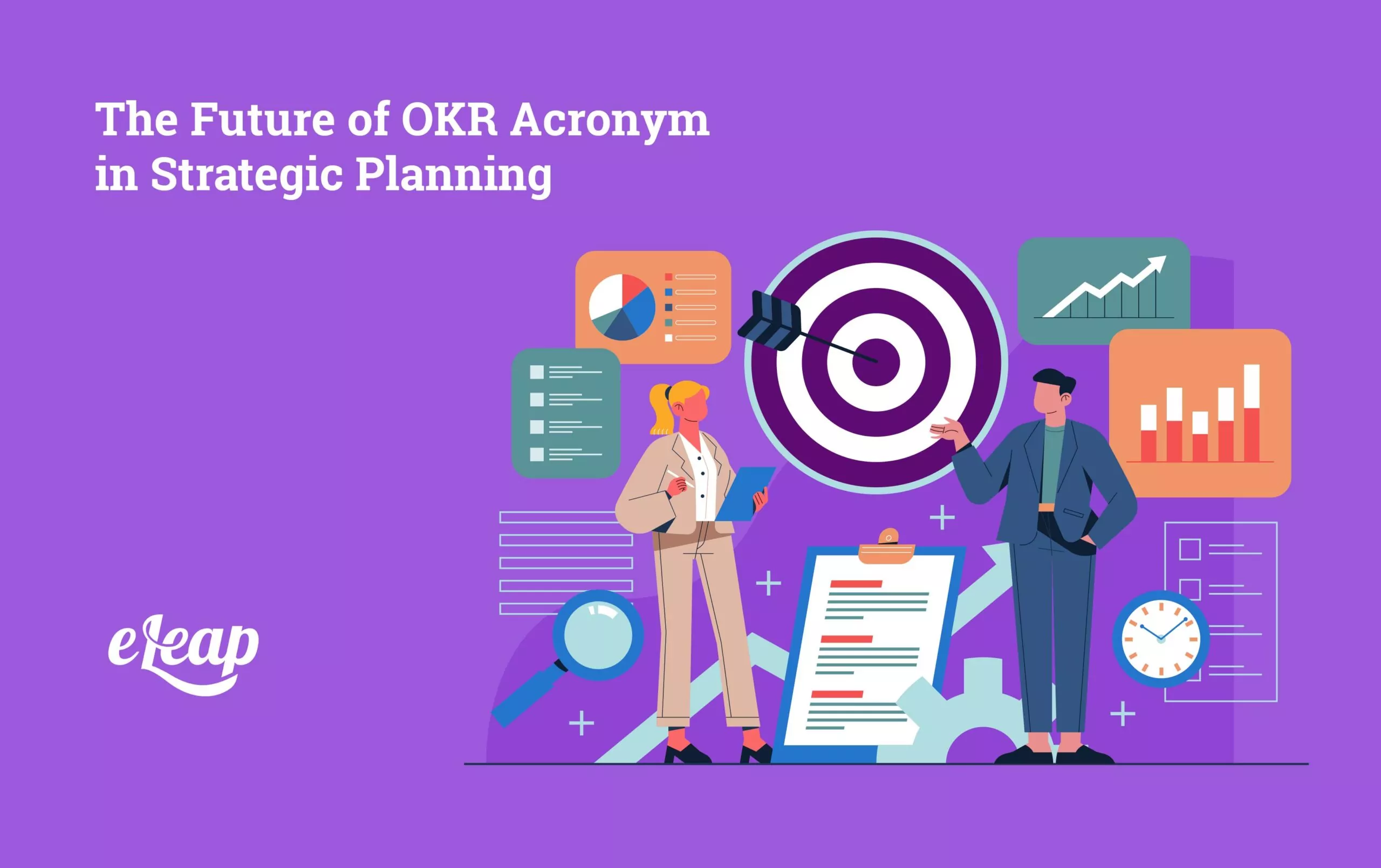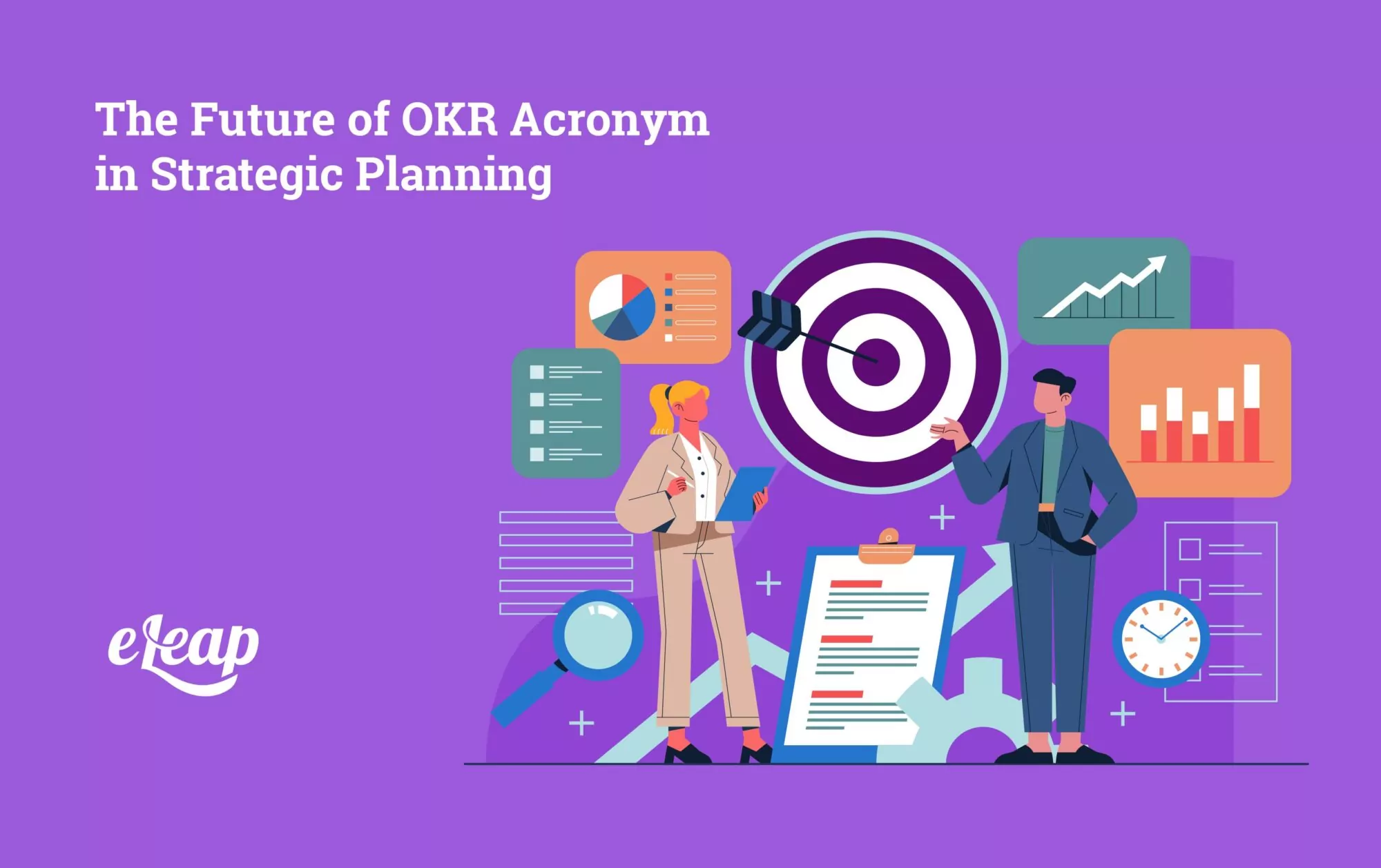The Future of OKR Acronym in Strategic Planning

The OKR acronym stands for Objectives and Key Results. Organizations use this framework to create measurable goals and track their outcomes. This methodology helps align individual, team, and organizational objectives clearly and quantifiable, making it indispensable for strategic planning. Explore how eLeaP®’s Performance Management Platform can simplify evaluations, boost productivity, and drive measurable results.
The origin of OKRs can be traced back to the early days of Intel, where Andy Grove introduced the framework in the 1970s. Grove, the former CEO, wanted a structured way to measure the effectiveness of business goals and ensure that the company’s objectives were aligned across all levels—his success in implementing OKRs led to its adoption by other companies, particularly in Silicon Valley. Google, for example, has successfully used OKRs since its early days, propelling its growth while maintaining alignment between individual contributors and the company’s long-term vision.
OKRs are not just about setting goals; they also provide a way to measure success, track progress, and adjust strategies as needed. The central concept behind OKRs is simple: define qualitative and aspirational objectives and then identify quantitative and measurable key results. This method fosters alignment and accountability, allowing teams to focus on what matters most to the business.
Why do OKRs matter in strategic planning? They provide a clear framework for translating high-level organizational goals into actionable tasks. By aligning OKRs with the company’s mission and vision, businesses can ensure that everyone—from leadership to individual contributors—works towards a common purpose. OKRs bring clarity to teams, reduce ambiguity, and enhance overall productivity.
The Role of OKRs in Modern Business Strategy

OKRs are central to modern strategic planning by enabling organizations to align their goals with measurable outcomes. The primary benefit of OKRs is their ability to provide a clear framework for tracking progress toward business objectives. Unlike traditional goal-setting methods, which often focus on outputs or subjective measures, OKRs concentrate on results that can be quantified, making success easier to track and adjust for.
Strategic alignment is a core feature of OKRs. In many organizations, employees may not fully understand how their day-to-day work connects to the broader goals of the business. OKRs bridge this gap by providing a framework for cascading objectives from top leadership to individual contributors. This process ensures that every employee’s work contributes directly to the organization’s success, creating a unified effort toward achieving common goals.
One primary benefit of using OKRs is the ability to implement a results-driven strategy. The Key Results are measurable outcomes that provide teams with a clear indicator of progress. Whether increasing revenue, improving customer satisfaction, or achieving operational efficiency, OKRs offer a structure for tracking these outcomes, helping businesses focus on key priorities.
Moreover, OKRs are flexible, making them suitable for businesses across industries. Whether it’s the tech sector, healthcare, or manufacturing, OKRs can be tailored to meet specific needs. Companies in the technology sector, such as Google and LinkedIn, have successfully employed OKRs to maintain alignment and drive innovation. In healthcare, organizations use OKRs to improve patient care outcomes, while manufacturers leverage the framework to optimize production processes and reduce costs.
The Strategic Benefits of OKRs
Incorporating OKRs into an organization’s strategic planning process offers several key benefits. Clarity and alignment are perhaps the most significant advantages. When objectives are clearly defined, teams can work with purpose and precision. OKRs also eliminate the confusion that often arises when employees are unsure of their priorities or how their work contributes to the company’s vision.
OKRs also promote transparency within the organization. Because progress is tracked and shared openly, all employees—whether in management or on the front lines—can see how their efforts contribute to the business’s success. This transparency fosters accountability, as teams are aware of not only their results but also the progress of others. Visibility into performance helps identify areas where adjustments may be needed, enabling businesses to pivot quickly and effectively.
Another notable benefit of OKRs is their ability to focus teams on high-impact goals. In many organizations, the sheer number of tasks can lead to a scattered focus, with teams working on numerous initiatives without understanding their relative importance. OKRs help businesses focus on the most crucial outcomes, ensuring that limited resources are directed toward the objectives that will have the most significant impact.
At eLeaP, OKRs streamline employee training and development, ensuring that each department is focused on growth-oriented, measurable goals. Focusing on high-impact results allows businesses to stay competitive in a rapidly evolving marketplace.
The Future of OKRs in Strategic Planning
As organizations continue to embrace digital transformation and adapt to an increasingly dynamic business landscape, the future of OKRs will undoubtedly evolve. Integrating artificial intelligence (AI) and automation with the OKR framework is one of the most significant trends. AI tools can help organizations track progress in real-time and analyze data. And make predictive adjustments to strategies, leading to more proactive goal management. This enhanced tracking capability allows businesses to stay on top of performance, spot trends early, and adapt their OKRs in response to new data.
OKRs are likely to become more dynamic and continuous in the future. While they are often set quarterly or annually, businesses are moving towards more agile approaches, where they are reviewed and adjusted regularly. This shift allows organizations to be more flexible and responsive to market changes, helping them stay aligned with rapidly shifting priorities. OKRs’ flexibility will enable businesses to adjust quickly, ensuring the organization remains focused on the most critical outcomes.
Another significant development in the future of OKRs is their adoption across remote and hybrid workforces. As more businesses shift to remote or hybrid work models, ensuring that all teams, regardless of location, are aligned and working towards the same objectives becomes increasingly essential. OKRs provide a clear framework for managing remote teams, offering transparency and accountability regardless of where employees are based.
Challenges and Pitfalls in OKR Implementation
While OKRs offer numerous benefits, they are not without their challenges. One of the most common pitfalls is overcomplicating them. When organizations try to set too many objectives or make key results overly complex, the framework loses its effectiveness. Clear, simple, and measurable goals are essential for OKRs to work correctly. Businesses must avoid the temptation to overcomplicate the process and instead focus on a few key objectives that will drive meaningful change.
Another challenge is aligning OKRs with company culture. OKRs are most effective when they align with the organization’s values and culture. A disconnect between the goals defined by OKRs and the company’s ethos can lead to confusion and disengagement among employees. To overcome this, businesses must ensure that their OKRs reflect their goals and how they want to achieve them.
Effective OKR tracking and reporting can be challenging, particularly as businesses scale. Without the right tools, managing OKRs across different teams can become cumbersome as organizations grow. Systems that streamline OKR tracking are needed, allowing for easy updates, status reports, and adjustments. Software platforms designed for OKRs, like eLeaP, can help manage these complexities by providing tools that enable transparent reporting and progress tracking.
Best Practices for Successful OKR Integration
Successfully integrating OKRs into a business requires careful planning and execution. First and foremost, it is essential to define clear and measurable objectives. OKRs should be specific, actionable, and time-bound. This clarity allows teams to understand what they need to accomplish and how their performance will be measured.
Another key best practice is the importance of regular check-ins and adjustments. OKRs should not be set in stone; businesses must continuously monitor progress and adjust as necessary. Regular review cycles ensure that teams stay on track and can make adjustments based on changing priorities or new information.
It is also critical to involve teams in the OKR process. When employees are engaged in creating OKRs, they are more likely to feel ownership over the process and remain committed to achieving the goals. Encouraging collaboration and feedback across departments ensures that OKRs are realistic, achievable, and aligned with the company’s broader objectives.
Conclusion
The OKR framework has proven valuable in helping businesses set and achieve measurable goals. As companies continue to evolve and adapt to new technologies, the future of OKRs is bright. Integrating AI, real-time progress tracking, and shifting toward continuous OKRs will allow organizations to stay agile and responsive to market changes.
To prepare for the future of OKRs, businesses should ensure that they are clear, measurable, and aligned with company culture. The key to success is maintaining flexibility while focusing on high-impact goals that drive meaningful results. With the right systems and tools in place, such as those offered by eLeaP. Organizations can maximize the effectiveness of their OKRs and create a culture of accountability, alignment, and growth.
As strategic planning continues to evolve. OKRs will undoubtedly play a central role in shaping how businesses approach goal-setting and performance management. This stage will ensure that organizations stay competitive and innovative in the future.